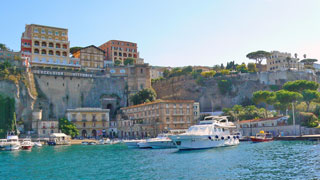|
Sorrento History
The legends indicate
a close connexion
between Lipara and
Surrentum, as though
the latter had been
a colony of the
former; and even
through the Imperial
period Surrentum
remained largely
Greek. The oldest
ruins are Oscan,
dating from about
600 BCE. Before the
Roman supremacy,
Surrentum was one of
the towns subject to
Nuceria, and shared
its fortunes up to
the Social War; it
seems to have joined
in the revolt of 90
BCE like Stabiae;
and was reduced to
obedience in the
following year, when
it seems to have
received a colony.
The most important
temples of Surrentum
were those of Athena
and of the Sirens
(the latter the only
one in the Greek
world in historic
times); the former
gave its name to the
promontory. In
antiquity Surrentum
was famous for its
wine (oranges and
lemons which are now
so much cultivated
there not having
been introduced into
Italy in antiquity),
its fish, and its
red Campanian vases;
the discovery of
coins of Massilia,
Gaul and the
Balearic Islands
here indicates the
extensive trade
which it carried on. |
 |
The position of
Surrentum was very
secure, protected by
deep gorges. The
only exception to
its natural
protection was 300
yards on the
south-west where it
was defended by
walls, the line of
which is necessarily
followed by those of
the modern town. The
arrangement of the
modern streets
preserves that of
the ancient town,
and the disposition
of the walled paths
which divide the
plain to the east
seems to date in
like manner from
Roman times. |